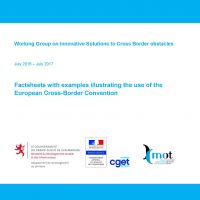The fourth conference of the Oradea process
Oradea | 26 October 2017
Oradea | 26 October 2017
The France-Hungary Initiatives Association (INFH), the Oradea Metropolitan Area and CESCI organized the first Oradea conference on the institutionalisation of cross-border cooperation in 2012, marking the start of the process named after the city of Oradea with the aim of strengthening, and supporting the cooperation between Hungarian and Romanian actors. Conferences organized over the last years provided the opportunity to share French, Romanian and Hungarian experiences related to cross-border health care cooperation and the forming of short supply chains. This year’s conference, which was hosted by the fortress of Oradea, focused on the protection and exploitation of cultural heritage.

The participants were greeted by Florin Birta, deputy mayor of Oradea and Angela Lupşa, director of the Museum of the Fortress, which gave place to the event. The latter also gave a presentation during the day, in which she presented the transnational project entitled Art Nouveau. Since Ordea is rich in unique Art Nouveau monuments, international network has already produced results beyond the specific project. The director took the participants of the conference for a walk in the fortress and invited them for lunch to the restaurant of the fortress.
The long-term renovation program of the city’s building stock was presented by the deputy chief architect, Adriana Lipoveanu. Her presentation, richly illustrated with photos, showed what a hard and traditionalist work has led to the second heyday of Oradea today. Mihai Jurca, head of the local tourism agency told how they are trying to make the architectural heritage marketable also from a tourism standpoint through organizing events. He also reported on the difficulties of this work, which will formulate the following years’ objectives as well.
In the conference, the French side was represented by José Osete, the director of the INFH, as well as Jonathan Fedy, responsible for heritage preservation and international cooperation from the Association des sites et cités remarquables de France, who also gave two presentations. In his first presentation, particpants could get an insight into the emergence and legal framework of the French heritage preservation (which is considered as pioneer worldwide), as well as of the association’s wide range of activities related to professional consultancy to heritage management. In his second presentation, he gave three good examples for mutual heritage management activities taking place along the French borders. The first one covers four valleys of the Savoy Alps, the second one is the joint program of the EGTC integrating 14 French and 7 Catalan municipalities, whereas the third one is exploiting the cultural heritage of a river valley, situated on the French Guiana–Suriname border. As the speaker highlighted, they are planning to establish the European Confederation of International Organisations dealing with cultural heritage preservation next year, which can be the main forum for the transfer of experience.
Secretary General of CESCI, Ocskay Gyula emphasized the importance of regional cooperation with three examples (Gothic road, the Fort Monostor in Komárom and the road of medieval churches). In his presentation he also pointed out the positive aspects as well as the deficiencies of each initiative, based on which he made a summary to successful cross-border heritage management.
José Osete highlighted in his closing remark the significance of cultural heritage preservation in such critical times, when mutual respect for European values has been weakened. As he said, there is a need for local identity in the age of globalisation as well, which cannot run counter to the identity of another nation. He expressed his hope, that the confederation of historic cities will be soon established in Romania as well, which could be an effective representation for the country’s local identity as a member of the confederation mentioned by Jonathan Fedy.

 Factsheets with examples illustrating the use of the European Cross-Border ...
Factsheets with examples illustrating the use of the European Cross-Border ...